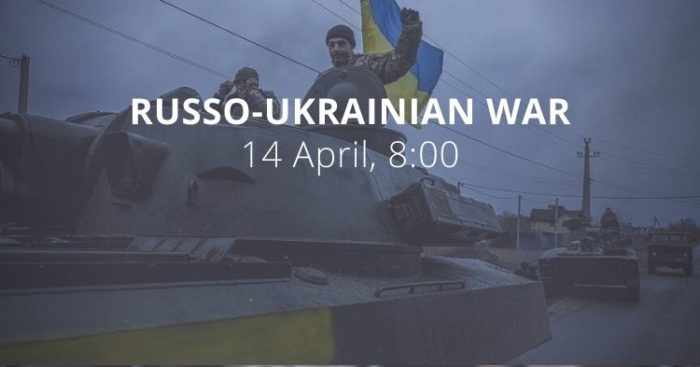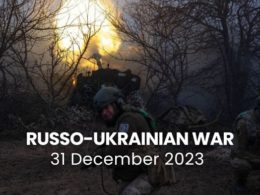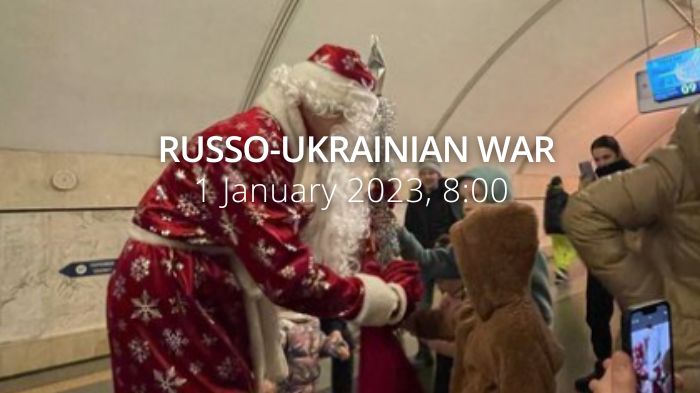Ukraine hit Russian missile cruiser “Moscow” with missiles, Russia strikes on military and civilian objects in the Kharkiv, Donetsk, and Zaporizhzhia Oblasts. Ukraine withstand a sophisticated Russian cyberattack on its power grid. Zelenskyy: “more than 500,000 Ukrainians have been forcibly displaced by the occupiers.” Pentagon will share more intelligence information with the Ukrainian military. EU adopted new €1.5 billion support package to Ukraine.
Morning report day 50 – April 14
Situation
According to information from the General Staff:
Russian forces continue to build an aviation group near the eastern border of our state, strengthen artillery units, and optimize existing command systems, intelligence and medical support.
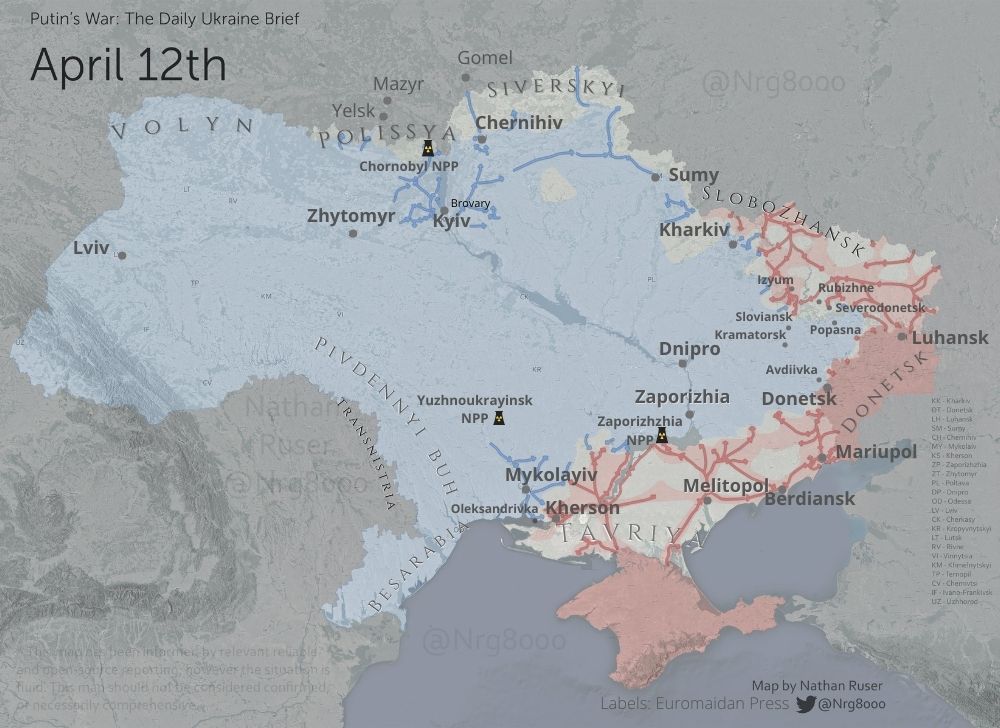
There is a constant missile threat throughout Ukraine from Russian forces.
The Russian occupiers continue to launch systematic missile and bomb strikes on military and civilian infrastructure in Kharkiv, Donetsk and Zaporizhzhia oblasts.
The enemy did not take active action in the Volyn and Polissya areas. Certain units of the Belarusian Armed Forces continue to carry out tasks to cover the Ukrainian-Belarusian border in Brest and Gomel regions. Planned combat training activities are underway.
In the Belarusian town of Kholmych, at the checkpoints, the military police of the armed forces of the Russian Federation and the Republic of Belarus are checking personal phones. Civilians are informed that Ukrainian units may attack Belarus at any time.
In the Siversky direction, the enemy is regrouping units of the Central Military District from the territory of the Bryansk and Kursk regions. After restoring combat capability, it concentrated these units in the Belgorod and Voronezh regions. The Russian forces strengthen border control, conduct engineering equipment for positions, and bases and ensure the presence of a small number of personnel, weapons, and military equipment.
In the Slobozhansky direction, the Russian forces conducted reconnaissance of probable areas of attack increasing the system of reconnaissance, management, and medical support. It continues to partially block the city of Kharkiv and shells the city with artillery, regroups units and replenishes supplies.
- Due to the impossibility of capturing it, the armed forces of the Russian Federation continue to use artillery to destroy the city’s infrastructure.https://twitter.com/EuromaidanPress/status/1514508800686014468?s=20&t=3G_rh5SzhTWbY7QowMtiTA
In the Luhansk direction Strengthening of the grouping of the Russian forces around Sievierodonetsk is carried out at the expense of separate divisions of the 2nd All Arms Army of the Central military district.
In the Donetsk and Tavriya directions, the Russian forces fought in the Slavyansk, Popasna, and Kurakhovo districts and stormed the city of Mariupol. It was not successful, and the fighting continues.
- On the territory of Donetsk and Luhansk oblasts, the defenders of Ukraine repulsed eight enemy attacks, destroyed a tank, four armored units and six vehicles, as well as one enemy artillery system.
In the Pivdennyi Buh direction, the Russian forces are taking measures to restore combat capability, replenish ammunition, take measures to engineer equipment positions, and exercise fire on units of our troops.
- The Russian enemy is fighting in the area of Alexandrivka. It is trying to resume the offensive to regain lost ground in the Osokorivka
- … the Russian forces conduct air reconnaissance to identify units of the Armed Forces of Ukraine.
Units of anti-aircraft missile forces of the previous day shot down two enemy fighters.
The Russian forces continue illegal actions against the civilian population in the temporarily occupied territories. The Russians are checking documents, personal belongings, and mobile phones. The Russian occupiers also carry out forced inspections of apartments.
In some occupied territories of Kharkiv oblast, the Russian forces have disrupted the cellular network. The Russian occupiers are exerting an aggressive informational and psychological influence on the population. It is mostly aimed at trying to convince of the futility of the fight against the Russian occupation forces. We urge citizens not to believe in hostile propaganda and to continue total resistance.
It is significant that the Russian forces continue to suffer losses in the temporarily occupied territories. So, in the period from March 20 to April 12, in the city of Melitopol, Zaporizhzhia oblast, about 70 servicemen of the Armed Forces of the Russian Federation were killed while patrolling the area at night.”
Ukraine hit the Russian Black Sea Fleet flagship “Moscow” with missiles, Cencor.net claimed last night. According to BBC the head of the Odesa regional administration, Colonel Maxim Marchenko, said that the Ukrainian military had hit the Russian missile cruiser Moskva with Neptune anti-ship cruise missiles and caused him serious damage.
Ukraine has reportedly hit Russian missile cruiser Moscow, the one who Ukrainian defenders on Zmiyinyi Island told to "go f*ck itself," w/ Neptune anti-ship missiles
Confirmed by Odesa RegHead Marchenko, Arestovych (says there is fire on board), Ukrayinska Pravda Intel sources pic.twitter.com/X7PfFPV4r8
— Euromaidan Press (@EuromaidanPress) April 13, 2022
The information about the incident on the cruiser Moskva was indirectly confirmed by Aleksey Arestovich, adviser to the head of the Office of the President of Ukraine. The information has not been officially confirmed by Ukrainian authorities. According to the Russian Defense Ministry, the ammunition detonated as a result of a fire on the Moskva missile cruiser, TASS and RIA Novosti report. “As a result of a fire, ammunition detonated on the missile cruiser Moskva. The ship was seriously damaged,” the statement said. The ministry said the cause of the fire is under investigation.
Ukraine says defenders of Mariupol consolidate, CNN reports. Ukrainian presidential adviser Oleksiy Arestovych said that “in Mariupol, as a result of a risky maneuver, units of the 36th Independent Marine Brigade broke through to join the Azov regiment.” Both units have been involved in a last-ditch attempt to resist a Russian offensive against the city that has lasted well over a month.
Russia’s defense ministry claimed that 1,026 soldiers of Ukraine’s 36th Marine Brigade had surrendered in Mariupol. Several independent Ukrainian outlets and government officials have, however, contrarily reported that the 36th Marine Brigade broke out and linked up with Ukrainian forces at the Azovstal plant. The commanders of the 36th Brigade and the Azov Regiment additionally released a joint video on April 13.
Ukraine says it thwarted a sophisticated Russian cyberattack on its power grid, The New York Times reports. Ukrainian officials said on Tuesday 12 April that they had prevented a Russian cyberattack on Ukraine’s power grid that could have knocked out power to two million people, raising fears that Moscow will increase its use of digital weapons. “Russia has long used online attacks alongside traditional warfare; just days before the Russian invasion began on Feb. 24, Ukraine said a cyberattack hit its Defense Ministry, its army, and two of its banks. But experts said the latest hacking — while unsuccessful — was among the most sophisticated cyberattacks they have seen in the war so far. It used a complex chain of malware, including some custom-built to control utility systems, suggesting that Russia had planned the attack over several weeks and intended to maximize the damage by sabotaging computer systems that would be needed to restore the electrical grid.”
During the last 24 hours, the Ukrainian General Staff has reported on the Russian manning and logistic challenges:
- Coercive mobilization measures continue in the temporarily occupied territories of Donetsk and Luhansk oblasts. Thus, in the city of Horlivka, daily tours of private houses and apartment blocks are held.
- In addition, it was established that the Russian command set a task to mobilize 60-70 thousand people on the territory of the so-called “DNR”. However, these figures were met by only 20 percent.
- In combat operations in parts of the south-eastern regions of Ukraine, separate units of the 103rd, 109th, 113th, 125th, and 127th Motorized Rifle Regiments operate as part of a group of enemy troops. They were recruited during the forced mobilization of men from the temporarily occupied territories of Donetsk and Luhansk oblasts. Structurally, these regiments number up to 5 battalions numbering about 300 servicemen in each. Only 5-10 percent of the personnel of these units have combat experience. The regimental command consists of officers of the armed forces of the Russian Federation. These groups have significant problems with the provision of weapons, ammunition, and medicine.
According to British Defense Intelligence, (last 24 hours):
- President Putin’s speech on Tuesday highlighted his continued interest in the Donbas where Russia is striking Ukrainian forces in preparation for a renewed offensive.
- Urban centers have faced repeated indiscriminate attacks from Russia throughout the conflict. The towns of Kramatorsk and Kostiantynivka are likely to be Russian targets for similar levels of violence.https://twitter.com/EuromaidanPress/status/1514557909404987394?s=20&t=3G_rh5SzhTWbY7QowMtiTA
- The combination of widespread missile and artillery strikes and efforts to concentrate forces for an offensive represents a reversion to traditional Russian military doctrine. However, this will require significant force levels. Ukraine’s continued defense of Mariupol is currently tying down significant numbers of Russian troops and equipment. operations.
As of Thursday 14.04.2022, the approximate losses of weapons and military equipment of the Russian Armed Forces from the beginning of the war to the present day: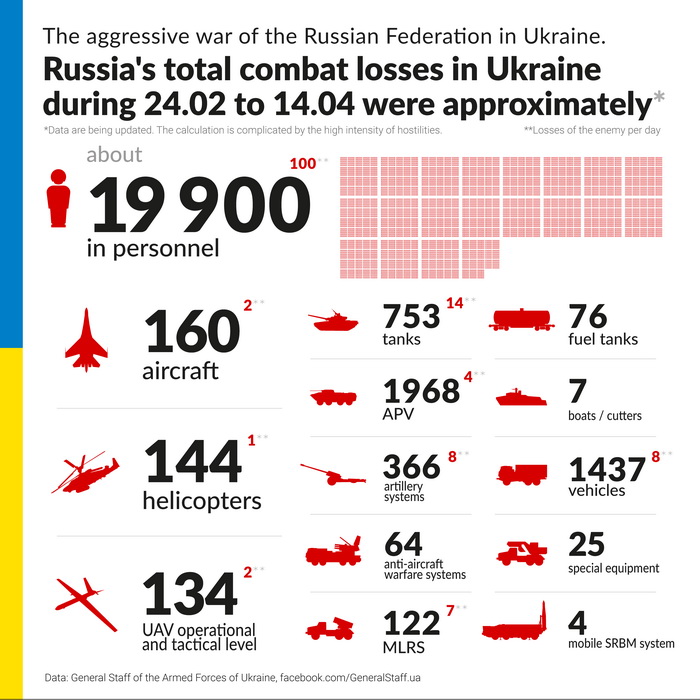
- Personnel – more than 19900 people (+100),
- Tanks – 753 units (+14),
- Armored combat vehicles – 1968 units (+4),
- Artillery systems – 366 (+8),
- Multiple rocket launchers – 122 (+7)
- Air defense means – 64 (no change),
- Aircraft – 160 (+2),
- Helicopters – 144 (+1),
- Automotive technology – 1437 (+8),
- Vessels/boats – 7 units (no change),
- Fuel and lubricant tanks – 76 (no change),
- UAV operational and tactical level – 134 (+2)
- Special equipment – 25 (no change)
- Mobile SRBM system – 4 (no change)
Humanitarian
Today, more than 500,000 Ukrainians have been forcibly displaced, President Zelenskyy said in his speech to the Riigikogu, Estonian Parliament.
Deported Ukrainians are deprived of documents. Their phones are being confiscated. They are trying to take these people to remote regions of the Russian Federation. Attempts to return to Ukraine are being hindered in every possible way. Children are separated from their parents and there are attempts of their illegal adoption in Russian families…”
According to UNHCR 4,656,509 refugees have been registered as of April 12. The UN says that so far Poland has taken in 2,669,637 refugees, Romania 709,249, Hungary 434,342, Russian Federation 433,083, Republic of Moldova 415,850, Russian Federation 433,083, Slovakia 323,020 and Belarus 21,852. Among those who fled Ukraine are also Ukrainian nationals with dual citizenship. An additional 113,000 people moved to the Russian Federation from the Donetsk and Luhansk regions between 21 and 23 February.
OHCHR recorded 4,521 civilian casualties in Ukraine as of midnight of April 12. 1,932 were killed (including 157 children) and 2,589 injured (including 250 children).
197 children were killed, and 351 children injured, the Office of the Prosecutor General of Ukraine reports as of 8 a.m. on April 14.
No humanitarian corridors worked on 13 April. According to the Deputy Prime Minister and Minister of Reintegration of Temporarily Occupied Territories of Ukraine:
“We are doing our best to reopen humanitarian corridors as soon as possible.
In Zaporizhzhia oblast, the occupiers have blocked evacuation buses, and in Luhansk oblast – they are violating the ceasefire agreement. The occupiers not only ignore the provisions of international humanitarian law but also cannot properly control their people on the ground – Minister explained – All this creates a high level of threat on routes that we have to abstain from opening humanitarian corridors today. But we will work to reopen it as soon as possible.”
Legal
Organization for Security and Co-operation in Europe (OSCE) presented Wednesday a “Report on violations of international humanitarian and human rights law, war crimes and crimes against humanity” in Ukraine:
Some violations and problems were also identified regarding practices attributable to Ukraine. The Mission is in particular concerned about the treatment of prisoners of war, who originally were considered criminals, and treated in ways that are incompatible with Geneva Convention III. Generally, allegations made by the Russian Federation could not be confirmed that Ukraine and not Russian forces had caused some of the death, injury, or destructions attributed to Russia by the media, Ukrainian authorities, and NGOs. …
While it has not been able to verify all the reported incidents that involve violations of International Human Rights Law (IHRL), it has found credible evidence suggesting that such violations concerning even the most fundamental human rights (right to life, prohibition of torture, and other inhuman and degrading treatment and punishment) have been committed, mostly in the areas under the effective control of Russia or entities under the overall control of Russia. The Mission has also concluded that the impact of the conflict on the enjoyment of human rights has gone beyond the direct violations of these rights. … Furthermore, the Mission has found that while the conflict has affected all the inhabitants of Ukraine, it has exerted and continues to exert particularly negative effects on individuals belonging to vulnerable groups, such as women, children, older persons or persons with disabilities.
The Mission is not able to conclude whether the Russian attack on Ukraine per se may qualify as a widespread or systematic attack directed against a civilian population. It however holds that some patterns of violent acts violating IHRL, which have been repeatedly documented in the course of the conflict, such as targeted killing, enforced disappearance, or abductions of civilians, including journalists and local officials, are likely to meet this qualification. Any single violent act of this type committed as part of such an attack and with the knowledge of it, would then constitute a crime against humanity.”
Russia’s leadership has ordered the destruction of any evidence of its army’s crimes in Ukraine, the Defense Intelligence of Ukraine (DIU) reports. After the Russian atrocities against Ukrainians in Bucha, Kyiv region, Russian troops began using mobile crematoria in Ukraine. 13 mobile crematoria have been registered in Mariupol to clean the streets of the bodies of dead civilians. The occupiers are trying to identify all potential witnesses to the atrocities through filtration camps and do away with them.
The military intelligence of Ukraine has repeatedly recorded the use of mobile crematoria in the Chernihiv region. The work of the enemy’s mobile crematorium was also recorded in Novoaydar, Luhansk oblast. According to DIU, Russian forces also use mobile crematoria to destroy the bodies of its own servicemen to hide the real number of casualties and to avoid paying compensation to their families. DIU claims that the actions of the Russian army fall under the definition of “genocide” following the Convention on the Prevention and Punishment of the Crime of Genocide and Article 6 of the Rome Statute of the International Criminal Court. The Russian leadership will, therefore, continue to try to conceal the facts of war crimes in Ukraine.
“Putin said to level everything,” DIU claims. Russia plans to destroy Ukrainian cities – materials of interception of telephone conversations of occupiers. As a part of the work of the Interdepartmental Coordination Center under the DIU, with the participation of the National Police of Ukraine, another interception of conversations between enemy servicemen reveals the plans of the Russian command for the war in Ukraine.
“Thus, a mobilized serviceman of the aggressor’s army, Oleg Karasev, told his wife about the instructions received by the Russian military on further action in Ukraine: Putin said that if we do not do anything by May 10, we will level everything. According to their information, there is an order to liberate Rubizhne, and we are flattening Lysychansk and Sievierodonetsk. … This conversation confirms that Russia has purposefully moved to the tactics of destroying Ukrainian cities and crimes against civilians on the direct instructions of the country’s top military and political leadership, including President Putin.”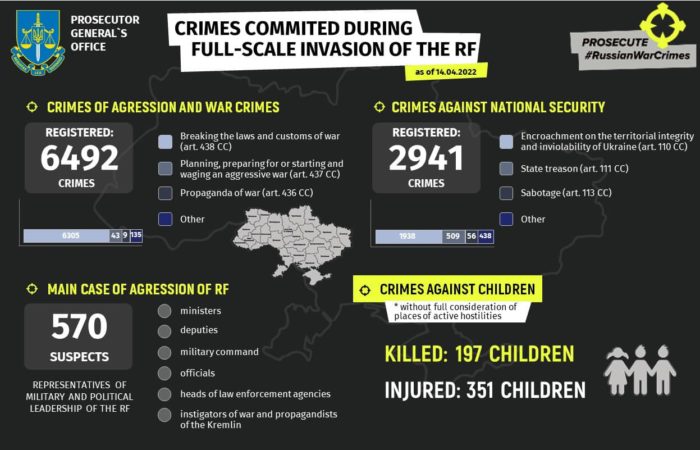
6492 crimes of aggression and war crimes and 2941 crimes against national security were registered as of 14 April. 1014 educational establishments are damaged as a result of shelling and bombings, 91 of them are destroyed fully.
Support
The US to share intelligence with Ukraine to defeat targets in Crimea and Donbas, Ukrainska Pravda reports citing the Wall Street Journal. The Biden administration will significantly expand the transmission of its intelligence, which it provides to Ukrainian forces so that they can target Russian troops in the occupied Donbas and Crimea. This is part of US support, which also includes a new aid package with heavier weapons. The decision to share additional intelligence and provide artillery marks a shift in the Biden administration’s approach to the conflict. But Moscow’s military strategy has changed: they have focused on eastern Ukraine, and this change has helped the US administration’s decision to intensify intelligence exchanges to help Ukraine better determine how the Russian military plans to attack and allow Ukrainians to respond with artillery, drones, and other weapons. The United States, however, will continue to refrain from providing intelligence that would allow Ukrainians to strike at targets in Russia.
New Package Of US Military Aid For Ukraine Includes Helicopters, Artillery, Biden Says, RFERL reports. The statement by President Joe Biden says
This new package of assistance will contain many of the highly effective weapons systems we have already provided and new capabilities tailored to the wider assault we expect Russia to launch in eastern Ukraine. These new capabilities include artillery systems, artillery rounds, and armored personnel carriers. I have also approved the transfer of additional helicopters. In addition, we continue to facilitate the transfer of significant capabilities from our Allies and partners around the world.”
EU support to Ukraine: Council agrees on the third tranche of support under the European Peace Facility for a total of €1.5 billion, according to a European Council press release. Today the Council adopted two assistance measures under the European Peace Facility (EPF) that will allow the EU to further support the capabilities and resilience of the Ukrainian Armed Forces to defend the territorial integrity and sovereignty of the country and protect the civilian population against the ongoing Russian military aggression. The EU will add €500 million to the resources already mobilised under the EPF for Ukraine. The agreed measures will finance both the provision of equipment and supplies to the Ukrainian Armed Forces by the EU Member States, including personal protective equipment, first aid kits and fuel, as well as military equipment designed to deliver lethal force for defensive purposes. The duration of the assistance measures is also extended by 24 months. Previous assistance measures were agreed on 28 February and 23 March 2022.
New US sanctions will force Putin to focus on the Russian economy over war, USA Today reports. Treasury Secretary Janet Yellen warned Wednesday that China and other nations declining to sanction Russia could face future economic fallout for failing to help end Russia’s “heinous war” in Ukraine. “Let’s be clear, the unified coalition of sanctioning countries will not be indifferent to actions that undermine the sanctions, Yellen said. A day earlier, Deputy Treasury Secretary Wally Adeyemo said the newest round of sanctions against Russian President Vladimir Putin will force him to focus more on his nation’s economy and less on the war.
The sanctions will target Russian supply chains including “military devices that have been built to use not only in Ukraine but to project power elsewhere, said Adeyemo, one of the main US coordinators of sanctions strategy. The White House said Russia’s GDP could contract up to 15% this year, and inflation is already spiking above 15%. But Russia has been able to stabilize key parts of its economy by artificially propping up the ruble, allowing it to rebound quickly as the US and its allies continue to pile on sanctions.”
Germany rejects the EU oil embargo on Russia at the moment, Reuters reports. Germany rejects a European Union ban on Russian oil at the moment and continues to oppose payments in rouble for Russian energy, a government spokesperson said on Wednesday. According to Reuters, major global trading houses are, however, planning to reduce crude and fuel purchases from Russia’s state-controlled oil companies as early as May 15, sources said, to avoid falling foul of European Union sanctions on Russia.
“The wording of EU sanctions exempts oil purchases from Rosneft or Gazpromneft, which are listed in the legislation, deemed as “strictly necessary” to ensure Europe’s energy security. Traders are wrestling with what “strictly necessary” means, the sources said.”
New developments
- Leaders of Poland and Baltic states in Kyiv to discuss military assistance, Reuters The presidents of Poland, Lithuania, Latvia, and Estonia arrived in Kyiv on Wednesday to meet Ukraine’s President Volodymyr Zelenskyy, the Polish leader’s office said. The meeting will focus on ways to assist civilians and the military in Ukraine, as well as with investigations of war crimes, said a spokesperson for Estonian President Alar Karis.
- President Macron calls Russians and Ukrainians “brothers”, UAWire In his interview with the public television channel France 2, he refused to use the term “genocide” to describe the actions of the Russian troops in Ukraine. “I would be careful with such terms because these two peoples (Russians and Ukrainians) are brothers. I want to continue to try, as far as possible, to stop this war and restore peace. I am not sure that the escalation of rhetoric serves this cause,” Macron said. At the same time, he added that Russia unilaterally launched an extremely brutal war, committing the war crimes and they will be investigated.“Fraternal people do not kill children, do not shoot civilians, do not rape women, do not mutilate the elderly, and do not destroy the homes of other ‘fraternal’ people. Even the fiercest enemies do not commit atrocities against defenseless people. At present, there are no moral or real grounds to talk about ‘fraternal ties’ between the Russian and Ukrainian peoples,” a spokesperson for the Ministry of Foreign Affairs of Ukraine, Oleh Nikolenko, told Ukrinform.
- President Duda: Sanctions to exclude Russia from the civilized international community must be imposed, Ukrinform Russia’s actions in Ukraine are not a war, but real terrorism and banditry, so sanctions must be imposed on the aggressor state to exclude it from the international community which respects civilized norms. President of Poland Andrzej Duda made the statement at a joint briefing with President Zelenskyy, President of Estonia Alar Karis, President of Lithuania Gitanas Nausėda, and President of Latvia Egils Levits in Kyiv on April 13”.
Assessment
On the War
The Institute for the Study of War has made the following assessment as of Tuesday 12 April:
Key Takeaways
- Russian forces continued to take ground in Mariupol, but Russian claims of a mass Ukrainian surrender are likely false.
- Russian forces continued unsuccessful local attacks in eastern Ukraine amid continuing preparations for a likely wider offensive.
- Russian forces continued to regroup in Kharkiv Oblast for offensive operations and conducted only minor attacks south of Izium.“
Professor Michael Clarke, a Sky News defense analyst, has made the following assessment on what follows when Mariupol falls.
The city of half a million people has been devastated, Clarke said – “there is nothing left of it as a city”. One thing that can be taken from the battle there, though, is the strength and audacity of the Ukrainian resistance over the last six weeks – experts say Vladimir Putin may have expected the city to fall in the first few days. This is something Ukrainian forces can cling to, Clarke said: “The cry will be ‘remember Mariupol’.”
Satellite images show Russian forces amassing in the east, The New York Times reports. Hundreds of Russian military vehicles, including tanks, armored personnel carriers, towed artillery and support equipment, are repositioning in eastern Ukraine, according to satellite images released on Wednesday.
The images offer further evidence that Russia is amassing forces for a new offensive to seize control of more of eastern Ukraine, which President Vladimir V. Putin on Tuesday defined as his main aim in the war since his attempts to take the capital, Kyiv, failed. Pentagon officials said this week that Russia was sending hundreds of military vehicles to eastern Ukraine, and satellite images released days ago by Maxar showed a long column of Russian military vehicles moving through the eastern village of Velykyi Burluk toward the Russian-controlled city of Izium. Russian units have seized Izium as they try to link up with other forces in the Donbas region.”
Putin bids to outnumber Ukrainian troops five to one in the Donbas region, The Times reports.
“Russia is attempting to muster a force that will outnumber Ukrainian troops in the east of the country five to one. A Ukrainian military source said Russian troops were being brought in from across the region for what Moscow hoped would be a decisive battle in Donbas. They insisted the force, comprising tens of thousands of soldiers, would still fall short of the number needed for Russia to win.”
Looming battle in Donbas to shape the course of Russia’s war in Ukraine, Reuters thinks. Russia is beefing up its forces for a new assault on Ukraine’s eastern Donbas region, setting the stage for a protracted battle that is certain to inflict heavy losses on both sides as the Russians try to encircle Ukraine’s fighters.
“Military analysts are wary of predicting who will win the battle for Ukraine’s industrial heartland of Donbas, a crucial conflict that will likely be brutal and ultimately define the course of the war. “The outcome of the battle could be that both sides will be battered to the point when neither one will be able to conduct an offensive or a counter-offensive,” said Konrad Muzyka, director of the Poland-based Rochan consultancy.
“Ukrainians will defend their land to the last man. The Russians will incur significant losses.” An uneasy “frozen” conflict could emerge and last for months with the constant threat of a fresh assault by Moscow, he said. … A protracted battle would frustrate any hopes that President Vladimir Putin has of declaring a significant victory in time for May 9 when Russia marks victory over Nazi Germany in World War Two with a huge military parade that the Kremlin leader oversees every year. …
Even without reinforcements now arriving, Russia’s invasion has slowly pushed back Ukrainian fighters in some areas of the Donbas and secured around 90% of the Luhansk region, said Nick Reynolds, a land warfare analyst at the RUSI think-tank in London. Ukraine’s troops have held on more robustly in Donetsk, which together with Luhansk makes up Russian-speaking Donbas, a swathe of which was seized by Russia-backed separatists in 2014. A significant Ukrainian contingent has been dug in since then.
Moscow could try to punch through Ukraine’s eastern front while advancing with troops, tanks and armored vehicles from the north and south in a pincer movement. That would seek to outflank and surround Ukrainian forces from behind, the analysts said. Fearing that their forces could be encircled, Ukrainian strategists will have to evaluate constantly whether they should pull the fighters back to avoid a quick, chaotic retreat in which they could become separated or smashed by artillery and aerial fire. “It’s disengaging from … the front line that’s going to be the problem. That’s one of the calls the Ukrainians are going to have to make,” Reynolds said.
Ukraine will likely try to avoid open tank battles, using artillery to target supply lines and equipment, and send raiding teams to attack convoys and logistics lines, analysts said.”
Consequences and what to do?
“The echoes of Syria grow louder in Ukraine” the Washington Post columnist Ishaan Tharoor argues.
As the war drags on, the parallels deepen. The Russian invasion has already spawned an enormous refugee crisis, hollowed out many Ukrainian cities and towns, and led to the suffering of countless Ukrainian civilians. The conflict, a growing body of analysts contend, ought to be seen in a continuum with Russia’s 2015 intervention in the Syrian civil war, which played a key role in turning the tide of battle in favour of embattled Syrian despot Bashar al-Assad.
The ruthless tactics and bombing campaigns that Russia unfurled across the Middle Eastern nation served as something of a trial run for the Russian war effort in Ukraine. And, in less than two months, the battles are producing effects on the ground that are tragically familiar to anyone who experienced or watched Syria’s decade-long implosion.
The echoes of the strife in Syria are growing louder in Ukraine, as my colleagues Claire Parker and Adam Taylor spelled out in separate pieces last month. Reports point to Russian strikes indiscriminately killing civilians, hitting hospitals, schools and knocking out vital infrastructure — with Mariupol the most glaring but far from the sole target to endure such bombardments.
As in Syria, “a lot of the civilian casualties that we’re documenting in Ukraine are being caused by dumb bombs — not targeted weapons,” Daniel Balson, advocacy director for Europe and Central Asia at Amnesty International, told Parker. “It’s impossible to use such weapons in these heavily built-up areas while ensuring that no civilians lose their lives.”
Syrian opposition activists argue that the seeming impunity with which Russia wreaked violence in support of the Syrian regime is once more in view in the rubble of Ukrainian cities. The Russians “are willing to devour the green and the dry,” said Radwan Alhomsy, a Syrian activist in southern Türkiye, deploying an Arabic idiom meaning to destroy everything in an interview with the New York Times last month. “They don’t care about the international community or anything else. We saw that in Syria. Burning schools is not new to us. It’s land they want to take, and they will take it.”
This week, as the Kremlin re-calibrates its Ukrainian war effort in the wake of stinging defeats in various parts of the country, President Vladimir Putin appointed a new commander of the war effort — one with experience in Syria. Gen. Alexander Dvornikov was the first commander to oversee Russia’s air war in defense of the Assad regime. “From his time in Syria, he is known in the west for having established the air superiority that allowed Russian and Syrian jets to carry out destructive bombing runs over Idlib and Aleppo, which killed scores of civilians,” noted the Financial Times.
In Ukraine, as in Syria, the fog of war has been further darkened by campaigns of misinformation and propaganda. After Ukrainian officials reported an alleged chemical weapons strike in Mariupol this week — one which is so far shrouded in confusion and unverified by any independent media — attention shifted to the ways in which Russia ran interference for the Syrian regime in its documented use of chemical agents in areas held by rebel forces. Russia’s role in helping create “humanitarian corridors” in Syria and forcibly transferring civilians out of cities the regime was recapturing has been apparently replicated in areas of eastern Ukraine overrun by Russian forces.
International rights groups see in Ukraine a continuation of trends witnessed in Syria and earlier wars in the Middle East. Last month, Agnes Callamard, secretary-general of Amnesty International, said the UN Security Council’s failure to act decisively on Ukraine — thanks, in no small part, to Russia’s right to a Security Council veto — marked yet another failure of the UN body and “a repetition of what we have seen in Syria.” …
Nevertheless, Syrian opponents of the Assad regime are now rallying behind Ukraine. An article in Agence France-Presse details how Syrian forensic experts are helping Ukrainians document war crimes and reports of chemical weapons attacks, while a group of doctors in rebel-held Idlib province are holding online classes for Ukrainian medics on how to treat casualties in the face of constant airstrikes and bombardments.
Assessment by Hans Petter Midttun
The sinking of the Russian flagship Moscow will have an impact on the Black Sea Fleets’ ability to operate. This is an event nearly comparable in scale and scope to the sinking of the Argentinian cruiser “Belgrano” 40 years ago, on 2 May 1992. The difference is that the sinking and presence of Royal Navy submarines effectively stopped the Argentinian Navy from taking part in the Falkland War. The attack on the Russian flagship will not have the same fundamental impact.
That said, it will still mark a significant change to the Black Sea Fleet’s freedom of action.
Firstly, the Russian Navy has lost its primary Air Defense unit in the northern part of the Black Sea. Notwithstanding the Anti-Access/Area Denial (A2/AD) capability on the Crimean Peninsula, this gives the Ukrainian Air Force greater freedom of action both over the Southern Ukraine as well as the adjacent sea areas. This means that the Black Sea Fleet is facing an increased threat.
Secondly, its ability to conduct an amphibious landing along the Ukrainian coast has been greatly reduced. Conducting an opposed landing is difficult enough without facing the threat from land launched cruise missiles during the last 6-8 hours of the approach to the landing area.
Thirdly, the Russian warships will no longer be able to close and engage targets ashore with artillery without running the risk of being sunk. The presence of shore-based Neptune and/or Harpoon missiles will reduce their ability to act with impunity.
Lastly, the cruise missile might not only have sunk the warship but might also have “sunk” the Russian morale as well. The Russian Armed Forces are already facing severe morale and motivations problems. Losing the flagship of the Russian Black Sea Fleet does not help. As a consequence, the Navy will face a far bigger risk than before (unless it remains at safe distance).
Unfortunately, the attack will have no impact on the Russian-imposed maritime blockade. In order to break that, NATO needs to deploy submarines and maritime task groups into the area, supported by an UN-mandated No-Fly Zone over the Black Sea.
What comes next might depend on whether Russia acknowledges the loss as a result of an attack or not. We might, therefore, expect Russia to retaliate and intensify its airstrikes and missile strikes against Ukrainian cities.




